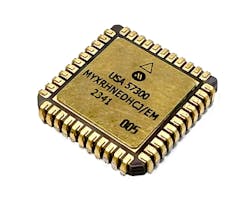Nuclear event detector to protect satellites and ground vehicles from radiation introduced by Micross
MELVILLE, N.Y. – Micross Components Inc. in Melville, N.Y. is introducing the company's MYXRHNEDHCJ series nuclear event detector (NED) to help sensitive electronic devices survive radiation from nuclear explosions.
The application-specific integrated circuit (ASIC) detects the initial rise of the gamma radiation pulse from a nuclear event and quickly shut down electronic systems for a brief interval to survive the blast and then resume normal operation.
Applications include missiles, satellites, ground vehicles, or any system that must survive a nuclear event. This new nuclear event detector IC is manufactured in the U.S. on the Jazz Semiconductor Trusted Foundry Inc. (JSTF).
Related: The evolving world of radiation-hardened electronics
The Micross MYXRHNEDHCJ series is available screened to Class H Military flow or Class K Space flow, and features integrated differential drivers to improve overall noise immunity, 300 percent greater radiation dose sensitivity, and 25 percent faster response times in comparison with legacy devices.
The new Micross radiation hardened NED reduce size, weight and power (SWaP); offer 4X lower minimum dose rate threshold coupled with reduced dose rate threshold variation over temperature; have increased noise immunity and sensitivity; offer wide variety of packaging options; and offer obsolescence mitigation via a vertically integrated in-house sourced PIN diode and ASIC.
For more information contact Micross online at www.micross.com/ned.
